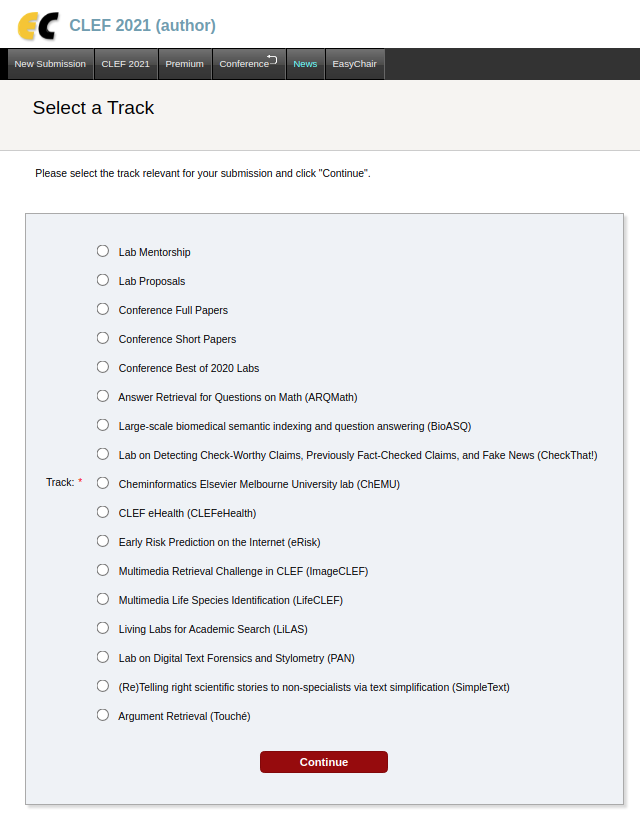
|
Instructions for CLEF 2021 Working Notes in the CEUR-WS Proceedings
As usually, the CLEF 2021 Labs working notes will be published in the CEUR-WS.org proceedings (http://ceur-ws.org/). The electronic Working Notes will be organised according to the Labs. If one group participates in more than one Lab, separate reports are to be submitted. Moreover, for those Labs that are subdivided in several tasks, separate reports for different task(s) are to be provided. The CLEF 2021 Working Notes will be divided into the following main sections (and sub-sections):
When the author logs into easychair they will find a separate "Easychair Track" for each CLEF Lab/Workshop and once they have selected the correct "Easychair Track" for their, as in the figure below.
→Select the track corresponding to your Lab/Workshop
Afterwards, in the paper upload form, after the keywords, authors will find a checklist with the "Submission Topics" corresponding to the different tasks in that Lab. Please mark those which correspond to your paper:
→ Mark the topic corresponding to the lab tasks which are described in your paper. For each task to which a group participated, groups are requested to submit a report describing their experiments. In the CEUR-WS working notes, there can be either a single paper for all the tasks to which a group participated or separated papers for each task. The decision on what is the most appropriate way to proceed for a given lab is up to the lab organizers. After the review process, if the paper will have been accepted, authors will be requested to submit the Camera-Ready Version of the paper, according to the reviewers’ recommendations. For each camera-ready submission, three items are required:
Paper Submission Submission of papers is to be done electronically through the EasyChair (https://easychair.org/my/conference?conf=clef2021). Using EasyChair for Paper Submission
Please, note that for preparing final Working Notes we will use the metadata of Easychair submission, so pay attention to insert authors names, title and affiliations correctly.
Deadlines Please remember that the strict deadline for receiving the final electronic versions of all papers is:
All the deadlines are intended to be MIDNIGHT CEST.
Copyright Form During the upload of the Camera-Ready version of the accepted papers, a scanned and signed version of the CLEF copyright form (it will be provided) must be uploaded with the source and PDF files of the submission (otherwise the submission will not be published in the final working notes).
When filling the copyright form:
It is mandatory to print the copyright form, sign it by hand, and upload a scan of the signed physical copyright form.
GUIDELINES TO PREPARE REPORTS FOR CLEF2021 WORKING NOTES The working notes papers are technical reports written in English and describing the participating systems and the conducted experiments. They should provide, at least, the following information:
The papers must be formatted according to CEUR-WS template available at https://drive.google.com/drive/folders/1K5encrAZu08WYdS5lREZ94gOOEvAUJqS?usp=sharing), either using Word or Latex one column templates. MAX LENGTH: no upper page limit is set, as papers are published only electronically, but experience teaches the overwhelmingly long papers are not effective. If you need to refer to the LNCS proceedings or to the Working Notes as a whole, here is the information about them:
LNCS Experimental IR Meets Multilinguality, Multimodality, and Interaction. Proceedings of the Tenth International Conference of the CLEF Association (CLEF 2021)
Editors K. Selcuk Candan, Bogdan Ionescu, Lorraine Goeuriot, Birger Larsen, Henning Müller, Alexis Joly, Maria Maistro, Florina Piroi, Guglielmo Faggioli, Nicola Ferro
CEUR-WS CLEF 2021 Working Notes Working Notes of CLEF 2021 - Conference and Labs of the Evaluation Forum
Editors Guglielmo Faggioli, Nicola Ferro, Alexis Joly, Maria Maistro, Florina Piroi
|



